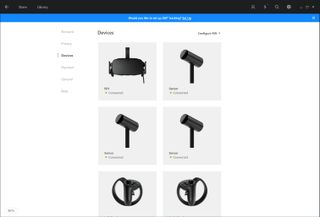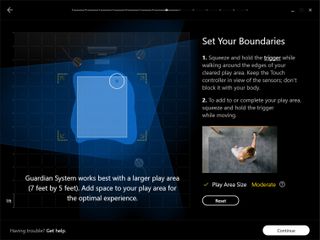Latest Oculus Software Update Officially Supports Room-Scale VR

Oculus released version 1.15 of its PC virtual reality software, and the new update brings several changes to the hardware setup process. Of particular note: Oculus no longer treats three-sensor configurations as experimental setups, meaning that Oculus 1.15 fully embraces room-scale VR configurations.
A little historical perspective is in order. At the end of March 2016, Oculus released the first modern consumer-grade VR system. The Facebook-owned company beat its competition to market by nine days. But when the HTC Vive hit the market, Oculus found itself trying to catch up on several fronts, especially motion controller integration and expanded play space.
Although Oculus announced its Touch controller nearly a year before the Rift hit the market, the company delayed the Touch release until December 2016. The Touch controllers narrowed the gap between the capabilities of the Rift and the Vive. Indeed, the Touch controllers are light, easy to use, and offer input options that the Vive controllers can’t (analog thumbsticks). When they shipped, the Rift platform enjoyed a rush of content releases (at the tail end of 2016), including a handful of Oculus exclusive titles. Game back on.

However, the Vive platform also included Valve’s Lighthouse technology, which powers the Vive’s tracking system. The Lighthouse system works with two base stations in opposing corners, and uses lasers to trip the sensors on the Vive. This tracking creates large virtual play spaces that you can wander around in. Valve dubbed this room-scale VR.
Oculus had developed its Constellation tracking system with the idea that people would place their sensors on the desk in front of them. This configuration allows for excellent standing-scale tracking, but limits you to a stationary position where rotating beyond, say, 180° would lead to occlusion issues and plague tracking accuracy. The company was still at work on a solution for room-scale VR.
To get from standing scale to 360° tracking with the Rift, you can place the Constellation sensors in opposing corners of a room, but this configuration won’t give you room-scale tracking. The Oculus system uses cameras to detect infrared lights on the Rift HMD, and the cameras don’t have a deep enough visible range to give you a room-scale space with two cameras. But when Oculus released the Touch controllers, it also released optional tracking sensors that you could add to your configuration. You don’t want to use four tracking cameras because the data would overload the USB controllers on your motherboard, but adding a third sensor opens the doors to room-scale tracking.

However, Oculus didn’t officially support 360° and room-scale tracking configurations. The company would allow you to set it up that way and provided an FAQ describing how to do it, but if something went wrong, you were on your own to figure it out. Officially, room-scale and 360° configurations were “experimental.” Using two front-facing sensors was the only acceptable configuration.
Stay on the Cutting Edge
Join the experts who read Tom's Hardware for the inside track on enthusiast PC tech news — and have for over 25 years. We'll send breaking news and in-depth reviews of CPUs, GPUs, AI, maker hardware and more straight to your inbox.
Last month, Oculus made moves to acknowledge three-sensor configurations officially. Oculus 1.14 introduced an automatic prompt that would guide you through a three-sensor configuration utility if it found a third sensor plugged in. Last month’s update didn’t officially support room-scale play spaces, though. Oculus 1.14 introduced official three-sensor 360° tracking support. Oculus 1.15 takes to support one step further and officially acknowledges sitting, standing, and room-scale three-sensor play spaces. It should be noted that two-sensor 360° tracking is still considered an experimental configuration.
The Oculus 1.15 software is available now. If you have the software installed and automatic updates enabled, you should already have the new version.
Kevin Carbotte is a contributing writer for Tom's Hardware who primarily covers VR and AR hardware. He has been writing for us for more than four years.
-
Jeff Fx Good to have Rift owners join us in the world of room-scale VR. It took Oculus a long time, but they're now delivering a full VR system.Reply -
SockPuppet Vive lighthouses are still far better. You don't have to have USB cables strung out all over the room to use the tracking. It was engineered as an all-in-one solution from the start.Reply -
Matko_1 You don't need 3 sensors for Rift room-scale. A third sensor barely improves tracking versus just 2 in opposing corners. I prefer the Rift touch controllers over the vive but the Rift has nothing on the Vive's tracking system which is better in every possible way.Reply
Also, to use 3 sensors many computers need a special USB card for the silly bandwidth needed. Some motherboards can cope but many can't. It's a ridiculous setup.
Most Popular

